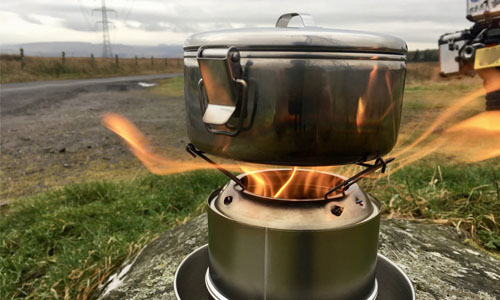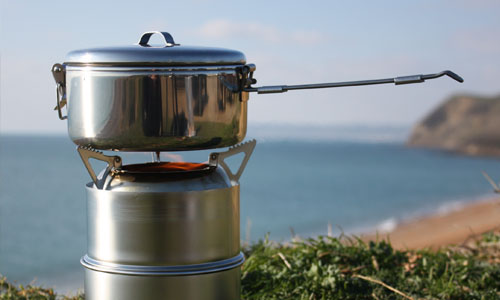Choosing the Best Fuel for Your Backpacking Stove
Author

Chris shares his passion for cycling, hiking, skiing, and climbing from Buxton, in the Peak District. As a blogger for Outdoor Look, Chris shares outdoor tips and indoor tricks to help you get the most out of your time spent outside. When he's not out adventuring he's making videos or trying to keep up with his 4-year-old son.
 During camping, hiking and other outdoor activities where you don’t have access to your kitchen, a backpacking stove becomes necessary. There are a few types of stove fuels that can be taken on your trip to prepare food. The most commonly used fuel is either gas or liquid. But, there are others as well, such as twigs, solid fuel, and even alcohol.
During camping, hiking and other outdoor activities where you don’t have access to your kitchen, a backpacking stove becomes necessary. There are a few types of stove fuels that can be taken on your trip to prepare food. The most commonly used fuel is either gas or liquid. But, there are others as well, such as twigs, solid fuel, and even alcohol.
If you are going to hike or camp for the first time in your young life, you must have proper knowledge about different types of backpacking stove fuels that are available in the market. Continue reading further to know which one is the best stove fuel for your hiking trip.
Gas Fuel
A gas fuel is a mixture of two liquid gases: propane and even isobutene. A canister gas stove is required to cook the food.
The canister is the most convenient cooking tool as a beginner can also use it easily. You can control the level of flame from low to medium to high. The potency of the fuel is stored in the canister for a longer period of time. It does not make your backpack heavy as it is lightweight. This type of stove is available at affordable rates.
Everything in this beautiful life has both up and downsides, and so is the way with gas fuel stoves. You may find it difficult to ignite in the winter season. When the canister is about to finish, the flame lowers down. To avoid shortage of fuel, make sure that you carry an additional canister with you.
Liquid Fuel
 Kerosene, petrol, and even diesel are considered liquid fuels. For this, you’ll need a refillable bottle which, when attached to a stove, produces a flame.
Kerosene, petrol, and even diesel are considered liquid fuels. For this, you’ll need a refillable bottle which, when attached to a stove, produces a flame.
The upside of liquid fuel is that they are available everywhere. You can take the required amount of fuel with you on the trip. If you are planning an outdoor trip in colder months, it is suggested to opt for liquid fuel as it performs fully in winter season.
There are a few cons, including the fuel's weight. It is also considerably costlier than gas-stoves. You need to refuel it very frequently and it requires constant maintenance. Before every single use, extensive priming is also necessary.
Twigs
These days, many famous brands manufacture wood-burning stoves. You have to use the wooden twigs to fuel these. These stoves are lightweight that can be carried easily, even in your backpack. So if you get this type of stove you are not going to run out of the fuel on your trip, unless twigs cease to exist.
Solid Fuel
The stoves that use the solid fuel tablets are inexpensive in comparison to other types of stoves. But the major con of these stoves is they release a strong odor that is extremely irritating. The fuel tablets tend to leave a greasy residue on the stove.
Alcohol
There are stoves available on the market that use denatured alcohol as a fuel. These stoves are affordable, lightweight and easy-to-use. The thru-hikers prefer them the most.
How to Recycle the Empty Canisters
The recycling of fuel canisters is a matter of utmost concern. Both the gas and liquid canisters are made for one-time use only. Therefore, you must dispose of them. Remember, that you’re not depositing them anywhere. Make sure to consult your local recycling and waste collection authorities for the procedure and rules of disposing.
Author

Chris shares his passion for cycling, hiking, skiing, and climbing from Buxton, in the Peak District. As a blogger for Outdoor Look, Chris shares outdoor tips and indoor tricks to help you get the most out of your time spent outside. When he's not out adventuring he's making videos or trying to keep up with his 4-year-old son.
- Speed Up Your Post-Hike Recovery with These 6 Essential Tips
- Cycling through Tranquil Roads and Coastal Views on the Isle of Wight
- The Essential Guide to Hiking Safety: 5 Tips Every Hiker Should Know
- Run Smart, Run Strong: Your Guide to Injury-Free Running
- Embrace Biking: Essential Tips for Beginners
Categories
- Sport (28)
- Product Reviews (3)
- Team Outdoor Look (7)
- Mike Wild (2)
- Mike Payton (2)
- Suse Hammond-Pears (3)
- Snowboarding (12)
- Latest Offers (105)
- Shop Talk (1)
- Competitions (7)
- Walking (413)
- Lifestyle Fashion (8)
- Travel (86)
- Kit Guides (176)
- Workwear Clothing (6)
- Safety Workwear (4)
- Health/Fitness (289)
- Skiing (91)
- Great Outdoors (1316)
- Cycling (92)
- January 2025
- December 2024
- November 2024
- October 2024
- September 2024
- August 2024
- July 2024
- June 2024
- May 2024
- April 2024
- March 2024
- February 2024
- January 2024
- December 2023
- November 2023
- October 2023
- September 2023
- August 2023
- July 2023
- June 2023
- May 2023
- April 2023
- March 2023
- February 2023
- January 2023
- December 2022
- November 2022
- October 2022
- September 2022
- August 2022
- July 2022
- June 2022
- May 2022
- April 2022
- March 2022
- February 2022
- January 2022
- December 2021
- November 2021
- October 2021
- September 2021
- August 2021
- July 2021
- June 2021
- May 2021
- April 2021
- March 2021
- February 2021
- January 2021
- December 2020
- November 2020
- October 2020
- September 2020
- August 2020
- July 2020
- June 2020
- May 2020
- April 2020
- March 2020
- February 2020
- January 2020
- December 2019
- November 2019
- October 2019
- September 2019
- August 2019
- July 2019
- June 2019
- May 2019
- April 2019
- March 2019
- February 2019
- January 2019
- December 2018
- November 2018
- October 2018
- September 2018
- August 2018
- July 2018
- June 2018
- May 2018
- April 2018
- March 2018
- February 2018
- January 2018
- December 2017
- November 2017
- October 2017
- September 2017
- August 2017
- July 2017
- June 2017
- May 2017
- April 2017
- March 2017
- February 2017
- January 2017
- December 2016
- November 2016
- October 2016
- September 2016
- August 2016
- July 2016
- June 2016
- May 2016
- April 2016
- March 2016
- February 2016
- January 2016
- December 2015
- November 2015
- October 2015
- September 2015
- August 2015
- July 2015
- June 2015
- May 2015
- April 2015
- March 2015
- February 2015
- January 2015
- December 2014
- November 2014
- October 2014
- September 2014
- August 2014
- July 2014
- June 2014
- May 2014
- April 2014
- March 2014
- February 2014
- January 2014
- December 2013
- November 2013
- October 2013
- September 2013
- August 2013
- July 2013
- June 2013
- May 2013
- April 2013
- March 2013
- February 2013
- January 2013
- December 2012
- November 2012
- October 2012
- September 2012
- August 2012
- July 2012
- June 2012
- May 2012
- April 2012
- March 2012
- February 2012
- January 2012
- December 2011
- November 2011
- October 2011
- September 2011
- August 2011
- May 2010
- April 2010
- March 2010
- February 2010
- January 2010
- November 2009
- October 2009
- September 2009
Submit a Comment